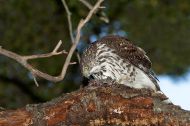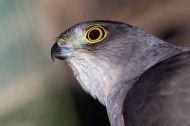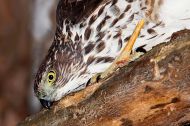Bicoloured Hawk
Esparvero Común
Accipiter bicolor
Length: 350mm (male) and 445mm (female). Coloration in both sexes is very similar. Bill bluish grey on the upper part and black at the tip, cere yellow; iris yellow; upperparts and sides of head very dark grey to blackish; malar, auricular and postauricular regions slate grey; nape feathers white at base and black at the tip; hind neck, back, scapulars, rump and uppertail coverts very dark grey to blackish; rectrices dark brownish grey with narrow terminal white band and five broad blackish bands; underside of tail whitish grey with blackish brown bands. Chin whitish, top of foreneck light slate grey; remainder of neck, breast, flanks and abdomen with alternate reddish brown, grey and whitish undulating bands; thighs reddish chestnut; undertail coverts white. Wing coverts as back; secondaries dark greyish brown; primaries dark greyish brown with blackish banding; underwing coverts and axillaries rufous; primaries and secondaries ventrally whitish grey with blackish banding. Legs lemon yellow. Juvenile: blackish cap; lower hind neck, back, scapulars and wing coverts dark brown with ochraceous buff margins; rectrices brown with blackish bands; chin and throat whitish; foreneck, sides of neck, breast, flanks and abdomen striated whitish buff and spotted with blackish brown; thighs reddish buff with dark brown spotting; undertail coverts white. Legs pale green. The cere is greenish and during the first months of life the iris is pearl grey, gradually changing until it reaches its definite yellow colour. In the adult female the breast, flanks and abdomen are more contrastingly coloured than in the male. Habitat and behaviour: the Bicoloured Hawk inhabits exclusively woodlands, where it carries out all its activity. It is a forest dweller adapted to pursuing its prey through foliage and branches of trees. For this purpose it is equipped with a long broad tail and short rounded wings, a combination which affords the necessary maneuverability to capture small birds that make up its staple food. In open fields flight consists of several short quick wing beats and a glide. Mostly solitary, during the breeding season it is found in couples.
Nests are constructed on the upper branches of tall trees and consist of a twig platform with soft materials lining the bottom; clutch size: five to six white eggs with scattered brown speckles.
At Mallín Ahogado, Río Negro, the authors found a nest of this species in a Colihue birch tree (Nothofagus dombeyi) containing two eggs, although only one hatched.
Fairly common, this species breeds in forests; in winter it is frequently seen in urban areas and the environs harrying small birds and baby chicken. Range: in northern Argentina up to Entre Ríos, Santiago del Estero and Catamarca the race Accipiter bicolor bicolor is found; in Patagonia the race Accipiter bicolor chilensis is distributed from Neuquén to Tierra del Fuego, mainly within the fringes of the subantarctic forests.
Illustrated Handbook of the Birds of Patagonia
Kindless: Kovacs Family
|











